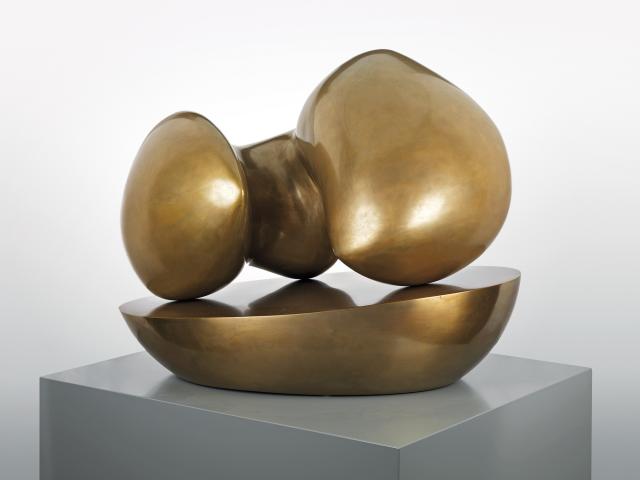Jean Arp was already 43 years old when he began doing sculpture in the round. In a process of condensing and solidifying, he transformed coloured wooden reliefs that had been previously done as “Concretions”, the name he gave to his sculptures from 1933 on. The artist created new forms that engendered correspondences between disparate worlds where the organic verges on the mineral. “We want to produce like a plant that produces fruit and not reproduce”, explained the artist.
Although it boasts a perfectly abstract look, Concrétion humaine sur coupe (Human Concretion on a Bowl) does allude to recognizable elements. Detached from the physical limitations of two-dimensional painting, the sculpture presents its rounded volume to the viewer in its entirety. And according to the different points of view that are adopted, the things the sculpture evokes grow in number and the images it suggests are transformed. Thus, the supple curves of this smooth bronze conjure up simultaneously anthropomorphic and plant forms. The round ample volumes seem to be the result of an inner force pushing outwards, revealing underlying energies. This fluidity in the outlines of the upper volume is balanced by the sharp edges and plane surface of the bowl that serves as a pedestal here. “Everything that is is Concretion and therefore art as well, only art would like to distance itself from nature and I characterise that separation, that tragic scission, as human.”
For Arp, nature represents an ideal to be attained with the help of the intellect. He was interested in nature’s mechanisms of birth, development and degeneration, and likened the human creative process to the movement of growth in nature. Yet Arp didn’t allow himself to copy natural forms. In his Concretions, it is indeed artistic – and hence human – creativity that is at work.
Although it boasts a perfectly abstract look, Concrétion humaine sur coupe (Human Concretion on a Bowl) does allude to recognizable elements. Detached from the physical limitations of two-dimensional painting, the sculpture presents its rounded volume to the viewer in its entirety. And according to the different points of view that are adopted, the things the sculpture evokes grow in number and the images it suggests are transformed. Thus, the supple curves of this smooth bronze conjure up simultaneously anthropomorphic and plant forms. The round ample volumes seem to be the result of an inner force pushing outwards, revealing underlying energies. This fluidity in the outlines of the upper volume is balanced by the sharp edges and plane surface of the bowl that serves as a pedestal here. “Everything that is is Concretion and therefore art as well, only art would like to distance itself from nature and I characterise that separation, that tragic scission, as human.”
For Arp, nature represents an ideal to be attained with the help of the intellect. He was interested in nature’s mechanisms of birth, development and degeneration, and likened the human creative process to the movement of growth in nature. Yet Arp didn’t allow himself to copy natural forms. In his Concretions, it is indeed artistic – and hence human – creativity that is at work.
